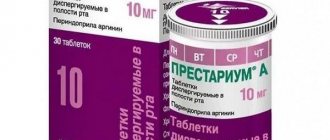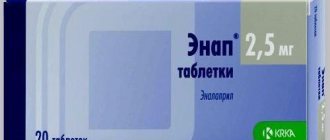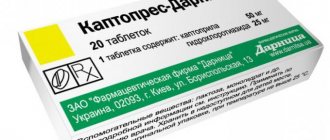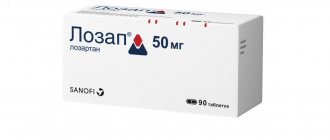Pharmacodynamics and pharmacokinetics
Pharmacodynamics
Antihypertensive drug with a combined composition of active ingredients.
Perindopril is an active ACE inhibitor that transforms angiotensin I into angiotensin II , which has a pronounced vasoconstrictor effect. ACE also has a destructive effect on bradykinin , which has a vasodilating effect. ACE inhibition increases the activity of the kallikrein-kinin system .
The pharmacological effect of Perindopril is determined by its active metabolite, perindoprilate , which has a pronounced therapeutic effect in arterial hypertension of any degree, in any body position, reducing systolic and diastolic pressure. blood flow decreases and peripheral blood flow increases, while heart rate remains unchanged.
The hypotensive effect is maximally manifested 4-6 hours after taking perindopril and persists throughout the day. The decrease in blood occurs quickly, and a pronounced therapeutic effect occurs 3-4 weeks after starting the drug and is not accompanied by tachycardia . withdrawal syndrome . In addition to the vasodilator effect. Perindopril reduces left ventricular hypertrophy and restores the elasticity and structure of blood vessels.
Amlodipine dihydropyridine derivative , and has a pronounced hypotensive and antianginal effect. Having a blocking effect, it reduces the process of transition of calcium ions into the cell. The antianginal effect is caused by the dilation of the blood vessels of the heart muscle and peripheral arteries: it reduces afterload on the myocardium, peripheral vascular resistance , myocardial oxygen demand, and relieves spasm of the coronary arteries. In patients with angina pectoris it reduces the severity of ischemia of the heart muscle , reduces the number of angina attacks, increases exercise tolerance, and reduces the need for nitroglycerin .
It has a pronounced dose-dependent hypotensive effect, which is caused by a vasodilating effect on the vascular muscles. Reduces hypertrophy of the left ventricular muscles, while it does not affect the conductivity and contractility of the myocardium, inhibits platelet , does not cause an increase in heart rate , and has a mild natriuretic effect. It does not affect metabolism and the concentration of lipids in the blood and can be prescribed to patients with diabetes , bronchial asthma , and gout . A pronounced therapeutic effect occurs after 6-10 hours and lasts for an average of about a day.
Pharmacokinetics
Perindopril is rapidly absorbed from the gastrointestinal tract after oral administration, while the bioavailability of perindopril with food is reduced. Cmax in the blood is reached within one hour. Low connection with blood proteins (20%). Pharmacological activity is achieved due to the metabolite - perindoprilate . Excreted in urine. T1/2 of perindopril is about one hour.
Amlodipine is well absorbed from the gastrointestinal tract , absolute bioavailability is 80%, food intake has no effect on bioavailability. Cmax in the blood occurs after 8-10 hours. Metabolized in the liver to form metabolites that do not have activity. It is excreted mainly in the urine.
Co-Dalneva® (Co-Dalneva®)
Amlodipine
During treatment with amlodipine, it is necessary to monitor body weight and sodium intake, and prescribe an appropriate diet. It is necessary to maintain dental hygiene and follow-up with a dentist (to prevent pain, bleeding and gum hyperplasia).
Low body weight patients, short patients and patients with severe hepatic impairment may require a lower dose.
CHF
In patients with CHF (functional class III and IV according to the NYHA classification), treatment is carried out with caution, due to the possibility of developing pulmonary edema. BMCCs, including amlodipine, should be used with caution in patients with CHF due to a possible increased risk of adverse events from the cardiovascular system and mortality.
Liver dysfunction
In patients with impaired liver function, T1/2 and AUC of amlodipine increase. Amlodipine should be started with the lowest doses and caution should be exercised both when starting therapy and when increasing the dose of amlodipine. In patients with severe hepatic impairment, the dose should be increased gradually and careful monitoring of the clinical condition is required.
Elderly patients
In elderly patients, T1/2 may increase and amlodipine clearance may decrease. No dosage adjustment is required, but careful monitoring of patients is necessary.
Indapamide
In the presence of liver dysfunction, taking thiazide and thiazide-like diuretics can lead to the development of hepatic encephalopathy. In this case, you should immediately stop taking the drug.
Photosensitivity
Cases of photosensitivity reactions have been reported while taking thiazide and thiazide-like diuretics. If a photosensitivity reaction develops, treatment should be discontinued. If it is necessary to continue diuretic therapy, it is recommended to protect the skin from exposure to sunlight or artificial ultraviolet rays.
Water and electrolyte balance
Sodium content in blood plasma
Before starting treatment, it is necessary to determine the sodium content in the blood plasma. While taking the drug, this indicator should be regularly monitored. All diuretics can cause hyponatremia, which sometimes leads to serious complications. At the initial stage of therapy, a decrease in sodium levels in the blood plasma may be asymptomatic, so regular laboratory monitoring is necessary. Elderly patients are advised to monitor plasma sodium levels more frequently.
Hyponatremia in combination with hypovolemia can cause dehydration and orthostatic hypotension.
A concomitant decrease in chlorine content in the blood plasma can lead to secondary compensatory metabolic alkalosis (the incidence and severity of this effect are insignificant).
Potassium content in blood plasma
Therapy with thiazide and thiazide-like diuretics is associated with a risk of hypokalemia. It is necessary to avoid hypokalemia (less than 3.4 mmol/l) in the following categories of patients from high-risk groups: elderly patients, malnourished patients, patients with liver cirrhosis, including edema and ascites, patients with coronary artery disease, CHF. In such patients, hypokalemia enhances the toxic effect of cardiac glycosides and increases the risk of developing arrhythmia.
Patients with a prolonged QT interval, either hereditary or drug-induced, are also at increased risk. Hypokalemia, like bradycardia, contributes to the development of severe cardiac arrhythmias, especially polymorphic ventricular tachycardia of the “pirouette” type, which can be fatal. In all the cases described above, regular monitoring of potassium levels in the blood plasma is necessary. It is necessary to determine the potassium content in the blood plasma during the first week after starting therapy. If hypokalemia is detected, appropriate therapy should be provided.
Calcium content in blood plasma
Thiazide and thiazide-like diuretics reduce the excretion of calcium by the kidneys, which may cause a slight temporary increase in calcium levels in the blood plasma. Severe hypercalcemia may be associated with previously undiagnosed hyperparathyroidism. In such cases, it is necessary to conduct a study of the function of the parathyroid glands, having first stopped taking diuretics.
Uric acid
In patients with elevated concentrations of uric acid in the blood plasma, the frequency of gout attacks may increase during therapy.
Renal dysfunction
Thiazide and thiazide-like diuretics are fully effective only in patients with normal or slightly impaired renal function (plasma creatinine concentration in adult patients below 25 mg/l or 220 µmol/l). In elderly patients, CC is calculated taking into account age, body weight and gender.
In patients with hypovolemia and hyponatremia at the beginning of diuretic therapy, a temporary decrease in GFR and an increase in the concentration of urea and creatinine in the blood plasma may be observed. This transient functional renal failure is not dangerous for patients with unchanged renal function, but its severity may increase in patients with renal failure.
In such patients, potassium levels and plasma creatinine concentrations should be regularly monitored.
Athletes
Indapamide may give a positive reaction during doping control.
Choroidal effusion/acute myopia/acute secondary angle-closure glaucoma
Sulfonamides and their derivatives can cause an idiosyncratic reaction, leading to the development of choroidal effusion with visual field impairment, acute myopia and an acute attack of secondary closed-angle glaucoma. Symptoms include sudden loss of vision or pain in the eye; usually occur within hours or weeks after starting thiazide/thiazide-like diuretic therapy. If left untreated, acute secondary angle-closure glaucoma can lead to irreversible vision loss. If symptoms occur, the thiazide/thiazide-like diuretic should be discontinued as soon as possible. If intraocular pressure remains uncontrolled, emergency medical treatment or surgery may be required. Risk factors for the development of angle-closure glaucoma are a history of an allergic reaction to sulfonamide derivatives and/or penicillins.
Perindopril
Double blockade of the RAAS
There is evidence of an increased risk of arterial hypotension, hyperkalemia and renal dysfunction (including acute renal failure) with simultaneous use of ACE inhibitors and ARB II or aliskiren. Therefore, double blockade of the RAAS by combining an ACE inhibitor with ARA II or aliskiren is not recommended (see section “Interaction with other drugs”). If a double blockade is necessary, it should be performed under strict medical supervision with regular monitoring of renal function, plasma potassium levels and blood pressure. Concomitant use of ACE inhibitors with aliskiren or drugs containing aliskiren is contraindicated in patients with diabetes mellitus and/or moderate or severe renal impairment (GFR less than 60 ml/min/1.73 m2 body surface area) and is not recommended in other patients.
Concomitant use of ACE inhibitors with ARB II is contraindicated in patients with diabetic nephropathy and is not recommended in other patients.
Neutropenia/agranulocytosis/thrombocytopenia/anemia
While taking ACE inhibitors, neutropenia/agranulocytosis, thrombocytopenia and anemia may occur. In patients with normal renal function in the absence of other risk factors, neutropenia rarely develops. After discontinuation of the ACE inhibitor, neutropenia and agranulocytosis resolve on their own. Perindopril should be used with extreme caution in patients with systemic connective tissue diseases during therapy with immunosuppressants, allopurinol or procainamide, especially in patients with impaired renal function. Some patients developed severe infections, in some cases resistant to intensive antibiotic therapy. When using perindopril in such patients, it is recommended to periodically monitor the number of leukocytes in the blood plasma. If any symptoms of infectious diseases appear (for example, sore throat, fever), patients should consult a doctor.
Hypersensitivity/angioedema
While taking ACE inhibitors, including perindopril, in rare cases, the development of angioedema of the face, extremities, lips, tongue, vocal folds and/or larynx may occur. If symptoms appear, you should immediately stop taking the drug and continue to monitor the patient until symptoms are completely relieved. As a rule, swelling of the face and lips does not require treatment, although antihistamines can be used to relieve symptoms.
Angioedema, accompanied by swelling of the larynx, can be fatal. Swelling of the tongue, vocal folds, or larynx can lead to airway obstruction. If such symptoms appear, you should immediately administer a subcutaneous solution of epinephrine (adrenaline) at a dilution of 1:1000 (0.3-0.5 ml) and/or ensure airway patency. Patients with a history of angioedema not associated with taking ACE inhibitors may have an increased risk of developing it when taking drugs of this group.
In rare cases, angioedema of the intestine develops during therapy with ACE inhibitors. In this case, patients complain of abdominal pain as an isolated symptom or in combination with nausea and vomiting, in some cases without previous angioedema of the face and with a normal level of C1-esterase. The diagnosis was made using computed tomography, ultrasound examination of the abdominal organs, or during surgery. Symptoms disappear after stopping ACE inhibitors. Therefore, in patients with complaints of abdominal pain taking ACE inhibitors. When carrying out differential diagnosis, it is necessary to take into account the possibility of developing angioedema of the intestine.
mTOR inhibitors
In patients concomitantly taking mTOR inhibitors (eg, sirolimus, everolimus, temsirolimus), therapy may be associated with an increased risk of angioedema (eg, swelling of the upper respiratory tract or tongue with or without respiratory distress).
Anaphylactoid reactions during desensitization
There are isolated reports of the development of anaphylactoid reactions in patients taking ACE inhibitors during desensitizing therapy (for example, hymenoptera venom: bees, wasps). The development of such reactions was avoided by temporarily discontinuing ACE inhibitors (at least 24 hours before desensitization); if an ACE inhibitor was accidentally taken, the anaphylactoid reaction occurred again.
Anaphylactoid reactions during LDL apheresis
In rare cases, life-threatening anaphylactoid reactions may occur in patients receiving ACE inhibitors during LDL apheresis using dextran sulfate. To prevent such reactions, ACE inhibitors should be temporarily discontinued before each apheresis procedure.
Hemodialysis
In rare cases, anaphylactoid reactions have developed in patients receiving ACE inhibitors during hemodialysis using high-flux membranes (for example, AN69®). Therefore, it is recommended to use a different type of membrane or use an antihypertensive drug of a different pharmacotherapeutic group.
Primary hyperaldosteronism
Patients with primary hyperaldosteronism are usually refractory to antihypertensive drugs that act by inhibiting the RAAS. Therefore, the use of this drug is not recommended.
Cough
During therapy with ACE inhibitors, a dry cough may occur. The cough persists for a long time while taking drugs of this group and disappears after their discontinuation. If a patient develops a dry cough, one should be aware of the possibility of its occurrence in connection with taking an ACE inhibitor. If it is necessary to use drugs in this group, taking an ACE inhibitor can be continued.
Aortic and mitral stenosis, HOCM
ACE inhibitors should be used with caution in patients with left ventricular outflow tract obstruction and mitral stenosis.
Diabetes
In patients with diabetes mellitus receiving oral hypoglycemic agents or insulin, regular monitoring of blood glucose concentrations is necessary during the first month of treatment with an ACE inhibitor.
Surgery/general anesthesia
The use of ACE inhibitors in patients undergoing surgery under general anesthesia can lead to a significant decrease in blood pressure, especially when using general anesthetic agents that have antihypertensive effects. It is recommended to stop taking long-acting ACE inhibitors, including perindopril, 24 hours before surgery.
Ethnic differences
In patients of the Negroid race, angioedema develops more often than in representatives of other races while using ACE inhibitors. Perindopril, like other ACE inhibitors, apparently has a less pronounced antihypertensive effect in patients of the Black race compared to representatives of other races. Perhaps this difference is due to the fact that black patients with arterial hypertension more often have low plasma renin activity.
Liver failure
In rare cases, cholestatic jaundice occurs while taking ACE inhibitors. As this syndrome progresses, fulminant liver necrosis develops, sometimes with death. The mechanism of development of this syndrome is unclear. If there is a significant increase in the activity of liver enzymes in the blood plasma or the appearance of jaundice while taking ACE inhibitors, you should stop taking perindopril and continue to monitor the patient.
Hyperkalemia
The use of ACE inhibitors may cause hyperkalemia due to inhibition of aldosterone release, which is usually mild in patients with normal renal function. Risk factors for hyperkalemia are renal failure, old age (over 70 years), diabetes mellitus, some concomitant conditions (dehydration, acute decompensation of CHF, metabolic acidosis), simultaneous use of potassium-sparing diuretics (spironolactone, eplerenone, triamterene, amiloride), potassium preparations, potassium-containing table salt substitutes, as well as other drugs that help increase potassium levels in the blood plasma (for example, heparin, trimethoprim or co-trimoxazole (sulfamethoxazole + trimethoprim) and especially aldosterone antagonists or ARA II, ASA ≥ 3 g / day, COX-inhibitors 2 and non-selective NSAIDs, immunosuppressants such as cyclosporine or tacrolimus (especially in patients with reduced renal function)). Hyperkalemia can lead to serious, sometimes fatal, heart rhythm disturbances. Caution should be exercised during the simultaneous use of ACE inhibitors and potassium-sparing diuretics and ARA II; renal function and serum potassium levels must be monitored.
Kidney transplant
There is no experience with the use of perindopril in patients with recent kidney transplantation.
Renovascular hypertension
The treatment method for renovascular hypertension is revascularization. However, the use of ACE inhibitors may be effective in patients with renovascular hypertension, both awaiting surgery and those who cannot undergo surgery.
In patients with bilateral renal artery stenosis or renal artery stenosis of a single functioning kidney during therapy with ACE inhibitors, there may be an increase in serum urea and creatinine concentrations (usually resolving when therapy is discontinued), and the risk of developing arterial hypotension and renal failure also increases. Taking diuretics may be an additional risk factor. Deterioration of renal function can be observed with even a slight change in plasma creatinine concentration, even in patients with unilateral renal artery stenosis.
Ko-Dalneva®
Renal dysfunction
Co-Dalneva® is contraindicated in patients with severe renal impairment (creatinine clearance less than 30 ml/min).
The drug Co-Dalneva® can be used in patients with moderate renal dysfunction (creatinine clearance 30-60 ml/min). For such patients, individual selection of doses of amlodipine, indapamide, and perindopril is recommended.
In some patients with hypertension without previous obvious renal impairment, laboratory signs of functional renal failure may appear during therapy. In this case, treatment with the drug should be stopped. In the future, combination therapy can be resumed using low doses of a combination of perindopril and indapamide, or these drugs can be used separately. Such patients require regular monitoring of potassium levels and creatinine concentrations in the blood serum 2 weeks after the start of therapy and every 2 months thereafter. The development of renal failure more often occurs in patients with severe CHF or underlying renal impairment, including renal artery stenosis.
In patients with diagnosed or suspected renal artery stenosis, treatment should begin with lower doses of Co-Dalneva®. Some patients may develop functional renal failure, which resolves after discontinuation of the drug.
Arterial hypotension and water-electrolyte imbalance
Patients with hyponatremia (especially with renal artery stenosis, including bilateral) are at risk of sudden development of arterial hypotension. Therefore, you should pay attention to possible symptoms of dehydration and decreased electrolyte levels in the blood plasma, for example, after diarrhea or vomiting. The use of ACE inhibitors causes blockade of the RAAS, and therefore may be accompanied by a sharp decrease in blood pressure and/or an increase in the concentration of creatinine in the blood plasma, which indicates the development of functional renal failure. These phenomena are more often observed when taking the first dose of the drug or during the first two weeks of therapy and sometimes develop acutely. Such patients require regular monitoring of blood plasma electrolyte levels.
In case of severe arterial hypotension, intravenous administration of 0.9% sodium chloride solution may be required. Transient arterial hypotension is not a contraindication for continued therapy. After restoration of blood volume and blood pressure, treatment can be resumed using low doses of perindopril and indapamide, or used separately.
Elderly patients
Before starting to take Co-Dalneva®, it is necessary to evaluate the functional activity of the kidneys and the potassium content in the blood plasma. At the beginning of therapy, the dose of the drug is selected taking into account the degree of decrease in blood pressure, especially in the case of a decrease in blood volume and loss of electrolytes, which helps to avoid a sharp decrease in blood pressure.
Atherosclerosis
The risk of developing arterial hypotension exists in all patients, but special caution should be observed in patients with coronary artery disease and cerebrovascular diseases. In such patients, treatment begins with low doses of the drug.
Children
The drug Co-Dalneva® is contraindicated for use in children under 18 years of age due to the lack of data on effectiveness and safety in this age group.
Contraindications
High sensitivity to the drug, age under 18 years, renal failure , pregnancy , lactation.
Use with caution in patients with CHF immunosuppressant therapy , cardiomyopathy , mitral/aortic stenosis , atherosclerosis , cerebrovascular diseases, hemodialysis , diabetes mellitus , when taking potassium-sparing diuretics , estramustine , dantrolene , lithium drugs, with scleroderma , lupus erythematosus , black patients ide race.
Use during pregnancy and breastfeeding
Taking Co-Dalneva for high blood pressure is strictly prohibited for women expecting the birth of a baby, since by penetrating the placental barrier, the medication can cause significant harm to the baby’s health and provoke congenital pathologies and developmental defects, such as:
- Kidney failure;
- Hyperkalemia;
- Hypotonic disease;
- Oliguria.
If pregnancy is detected during a therapeutic course, the drug must be immediately discontinued and a comprehensive medical examination must be completed. After birth, the baby must be under strict medical supervision for a certain time.
When planning a pregnancy, you should stop taking the pills several months before the expected conception.
Ko-Dalneva tablets are contraindicated for women during breastfeeding. During lactation, you need to either stop taking the drug or transfer the baby to artificial formula.
Side effects
Local allergic reactions, nausea, dyspepsia , diarrhea , weight change, tinnitus, agranulocytosis, leukopenia/neutropenia, thrombocytopenia, visual disturbances , headache , drowsiness , sleep disturbance , dizziness , insomnia , tremor , mood lability , fainting , palpitations, cough, shortness of breath , abdominal pain, vomiting, constipation , hepatitis , skin rash and itching, alopecia increased sweating , myalgia , photosensitivity , muscle spasms, arthralgia , frequent urination, peripheral edema , impotence , increased fatigue, asthenia , malaise.
Drug overdose
Use of the drug Co-Dalneva in dosages exceeding the maximum permissible may lead to the appearance of the following alarming clinical signs:
- Tachycardia;
- A sharp drop in blood pressure, the development of a hypotensive crisis;
- Nausea and profuse vomiting;
- Convulsive syndrome;
- Peripheral vasodilation;
- Oliguria;
- Severe dizziness;
- Confusion;
- Violation of water and electrolyte balance.
An overdose of Ko-Dalneva can cause the development of a state of shock and the death of the patient! Therefore, if such symptoms occur, it is necessary to call an ambulance, and before the arrival of medical specialists, perform a gastric lavage on the victim, inducing artificial vomiting, allow him to take sorbents, and lie him down with his legs raised above the level of the body.
Further treatment is prescribed by the doctor individually and is symptomatic.
Dalneva, instructions for use (Method and dosage)
Dalnev tablets are taken orally before meals, preferably before breakfast, 1 tablet once a day.
For patients with stable angina or arterial hypertension, the dose is selected based on the results of dose titration: amlodipine and perindopril . The maximum daily dosage of amlodipine is 10 mg; perindopril - 8 mg.
Dalneva should not be prescribed to patients with CC less than 60 ml/min. The use of Dalnev requires caution in patients with liver failure , since there are no recommendations on the dosage of the drug for such patients. Patients over 60 years of age do not require dose adjustment.
What is Ko-Dalneva prescribed for?
Therapists and cardiologists strongly recommend that patients drink Co-Dalneva for high blood pressure if they have the following clinical indications for use:
- Arterial hypertension;
- Hypertonic disease;
- Essential hypertension.
- Chronic heart failure.
The tablets are prescribed to people with diagnosed hypertension who require concomitant treatment with perindopril, amlodipine and indapamide. The drug is especially effective in severe forms of arterial hypertension, accompanied by a significant increase in blood pressure, edema, increased heart rate, and heart rhythm disturbances. Helps avoid the development of heart failure or eliminate its symptoms.
Interaction
When taking Dalneva together with Baclofen , there is a risk of increasing the hypotensive effect of the drug. With simultaneous use of the drug with drugs with a hypotensive effect, α-blockers ( Tamsulosin , alfuzosin , Prazosin , Terazosin , Doxazosin ), neuroleptics , general anesthesia, tricyclic antidepressants , an increase in the hypotensive effect and the development of orthostatic hypotension . Corticosteroids and tetracosactide reduce the hypotensive effect of Dalnev.
Analogues of Dalnev
Level 4 ATX code matches:
Tarka
Prestance
Drugs with similar therapeutic effects include: Amzaar , Amlodipine , Amlong , Vamloset , Duplekor , Kalchek , Lisinopril , Lizacard , Iruzid , Prestance , Liten , Rasilam , Tenliza , Equacard and others.
Dalneva price, where to buy
The price of Dalnev tablets 5 mg + 4 mg No. 30 varies between 385 - 590 rubles per pack. You can buy Dalnev without difficulty in most pharmacies in Moscow and other cities.
- Online pharmacies in RussiaRussia
ZdravCity
- Dalneva tab.
10mg+ 8mg n30Krka-Rus LLC 500 RUR order - Dalneva tab. 5mg+ 8mg n30Krka-Rus LLC
RUR 499 order
- Dalneva tab. 5mg+ 4mg n30Krka-Rus LLC
RUR 379 order
- KO-Dalneva tablets 5mg+1.25mg+4mg 30 pcs. Krka-Rus LLC
489 RUR order
- KO-Dalneva tablets 5mg+2.5mg+8mg 30 pcs. Krka-Rus LLC
RUR 561 order
Brief information about the drug
Co-Dalneva's blood pressure medicine belongs to the pharmacological group of antihypertensive drugs, angiotensin-converting enzyme inhibitors. Produced in Slovenia.
Release form
The blood pressure medicine Ko-Dalneva is presented on the modern pharmaceutical market in the most convenient tablet form for dosing and use at home. Sold in blisters (10 or 14 tablets). The medicine can also be purchased in cardboard packages containing 10 blisters from 2 dollars.
Compound
The drug contains 3 main active components:
- indapamide - 0.625, 1.25 or 2.5 mg;
- perindopril - at a dose of 10.206, 20.412 or 40.824 mg;
- amlodipine - in the amount of 6.935 or 13.87 mg.
The tablets also contain auxiliary ingredients: magnesium stearate, starch, colloidal silicon dioxide, sodium bicarbonate.
pharmachologic effect
Co-Dalneva for high blood pressure is a drug with a pronounced antianginal and hypotensive effect.
Packaging of Ko-Dalneva tablets
Terms and storage mode
It is recommended to store the medication in its packaging at a temperature not exceeding +25°C. It is important to ensure that children and pets do not have access to the medicine. The maximum permissible shelf life of the drug is 2 years.
Terms of sale
You can purchase a medicine in pharmacy chains only after presenting an appropriate doctor's prescription.
Cost of tablets
The exact cost of the drug is influenced by factors such as the dosage of the main active ingredients, the number of blisters in the pack and tablets in the package. The approximate price of Ko-Dalnev tablets varies from 250 rubles to 1000 rubles.









